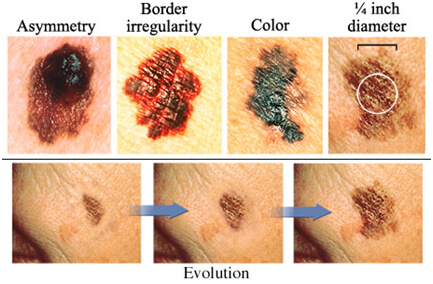Do you remember sunbathing for hours at peak times to get the kiss of color before prom or graduation? Or perhaps it was to prove your indulgence of your time vacationing at a beach, which is validated by the bronze glow!
One thought that eludes our fun in the sun is the fact that years later, we may pay for it with our health. May is National Melanoma Skin Cancer Awareness Month. As we welcome summer, vacations and fun in the sun, it’s important to review 5 things for our patients and ourselves in this 2 part series!
#1: Know the facts about melanoma

- Melanoma accounts for less than two percent of overall skin cancer cases, but the vast majority of skin cancer deaths.
- On average, a person’s risk for melanoma doubles if he or she has had more than five sunburns.
- Melanoma is one of only three cancers with an increasing mortality rate for men, along with liver cancer and esophageal cancer.
- The majority of people diagnosed with melanoma are white men over age 50.
#2: Learn the ABCDE’s
These are the characteristics dermatologists use to classify melanomas. If you witness a change in appearance of a mole on yourself or a patient, it is recommended to get it checked out by a professional.

A – Asymmetry: If one half of a mole does not match the other half.
B – Border Irregularity: The edges of a mole are blurred, jagged, can look like there isn’t a border.
C – Color: Inconsistent color or pigment. Going from tan to red, blue or mottled appearance.
D – Diameter: The size is greater than 6 mm in diameter should get a doctor to check it out. This is about the size of a pencil eraser.
E – Evolution: A change in the size, shape, color.
Dental Hygienists have the opportunity to spend the most time with patients. Taking the time to ask questions or share the facts for melanoma may lead into a conversation regarding the risks such as sun exposure, prior history with skin cancer or a weakened immune system.
Next, take a moment to ask whether there have been any changes to existing moles on their ears, neck, arms, hands or head. Not only will it inform your patient of what to notice on themselves and their loved ones, it will set you and your practice apart as an unmatched value from your patients’ perspective.
Stay tuned for Part 2!
Anastasia L. Turchetta, RDH
America’s Dental Hygienist
www.AnastasiaTurchetta.com